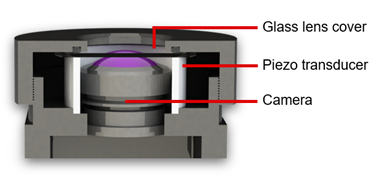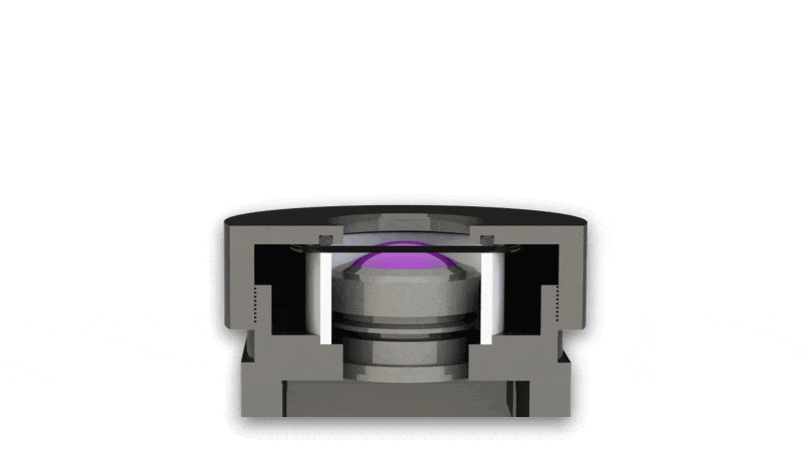SSZT077 may 2022 DRV2901 , ULC1001
You’ve probably heard that it’s possible to shatter glass by screaming at a high-pitched tone, but have you heard of cleaning glass by screaming? With precisely controlled, high-frequency vibrations, ultrasonic cleaning technology can clean glass surfaces. On a rainy day this technology could automatically detect and clear raindrops from a car’s rear camera lens without requiring action from the driver.
In this article, I’ll discuss ultrasonic lens cleaning or ULC technology and how it can help make self-cleaning camera applications a reality.
How Does Ultrasonic Lens Cleaning Technology Work?
Let’s start with the physics. All objects have a natural frequency determined by their molecular structure and geometry. This is a unique frequency at which the object vibrates or oscillates after applying energy to it. For example, a guitar string vibrates at its natural frequency when strummed. Similarly, a wine glass vibrates at its natural frequency when struck. If you repeatedly apply energy to a material specifically at its natural frequency, the incoming waves will constructively interfere with the existing waves – making them more intense but still in the same phase. This phenomenon is known as resonance.
To better understand resonance, imagine that you’re pushing someone on a swing. Pushing at exactly the right moment when the swing is at the peak of the backswing will cause the person to swing higher. Conversely, if you push at the wrong time (for example, if you’re out of sync with the person swinging), you will absorb some of the mechanical energy into your arms and attenuate the height of the swing motion.
Glass, silicon and polycarbonate lenses all have natural frequencies depending on their shape and thickness. Applying an ultrasonic vibration (or vibration outside the human hearing range) at the natural frequency of these materials will cause them to resonate. Much like how screaming at the natural frequency of a glass object can cause it to resonate to the point of shattering, precisely applying ultrasonic vibration in special patterns using piezo transducers and advanced semiconductors can effectively blast off water, dirt and other contaminants from a surface. Figure 1 below shows a cross section of an ultrasonic lens cleaning system. Figure 2 subsequently shows an animation of an ultrasonic lens cleaning system expelling water. Although an ultrasonic lens cover would normally vibrate with approximately 10 micrometers of displacement, which is less than a human eye can perceive, the animation is exaggerated for demonstration purposes.
 Figure 1 An Ultrasonic Lens Cleaning System
Figure 1 An Ultrasonic Lens Cleaning System Figure 2 Animation of an Ultrasonic Lens Cleaning System Expelling Water
Figure 2 Animation of an Ultrasonic Lens Cleaning System Expelling WaterWhy Is This Technology Important?
In 2014, the U.S. Department of Transportation mandated rear backup cameras for cars made after May 1, 2018. Today, some cars have as many as eight cameras and other exterior sensors using technologies such as lidar.
These cameras and sensors are only useful when their lenses are clear and unobstructed; a splash of mud or rain can easily disable autonomous features. So as automobiles become smarter, safer and more sophisticated, there will likely be new mandates for these sensors to operate in all weather conditions for applications such as autonomous emergency braking.
While ultrasonic cleaning already exists in the medical field using tubs of water, innovations in mechanical design, software algorithms and semiconductor integration have enabled ultrasonic surface cleaning in open air. Self-cleaning camera lens technology isn’t limited to the automotive industry, either; practically any application with cameras could leverage the technology, including traffic monitoring cameras, endoscopes, and machine vision cameras.
What about Other Cleaning Methods?
Automotive original equipment manufacturers have experimented with camera cleaning methods such as miniaturized windshield wipers, compressed air and spinning lenses. Unfortunately, these methods are overly complex, expensive and don’t work in all scenarios. Some high-end vehicles feature hidden water jets that wash their camera lenses, an approach that requires extra plumbing and additional fluid tank capacity. But water jets can’t clear ice, and don’t help when it’s raining.
Ultrasonic lens cleaning systems can use mechanical vibrations to rapidly generate heat, melt ice and blast away water. They can continuously clear rain from lenses by automatically sensing water and atomizing it through vibration. With the right algorithms and mechanical design, these systems can remove other containments such as dust, mud or even insects. This may sound complex, but application specific semiconductors could handle this task in a very small footprint. Using application-specific semiconductors such as the ULC1001, an automatic ultrasonic lens cleaning system could be self-contained, relying on nothing more than a power supply and an optional data line.
Conclusion
Given the need for safe and reliable cars, I expect the automotive industry to adopt ultrasonic lens cleaning; other types of end equipment, such as automated systems for agriculture, traffic cameras and sports filming, will also likely adopt this technology for its performance advantages, operational efficiency and streamlined maintenance. While ultrasonic lens cleaning isn’t quite the same as screaming, this technology is definitely worth a shout of excitement.
Learn more about ULC in the technical article, "Ultrasonic lens cleaning: A solid-state technology you didn't know you needed."